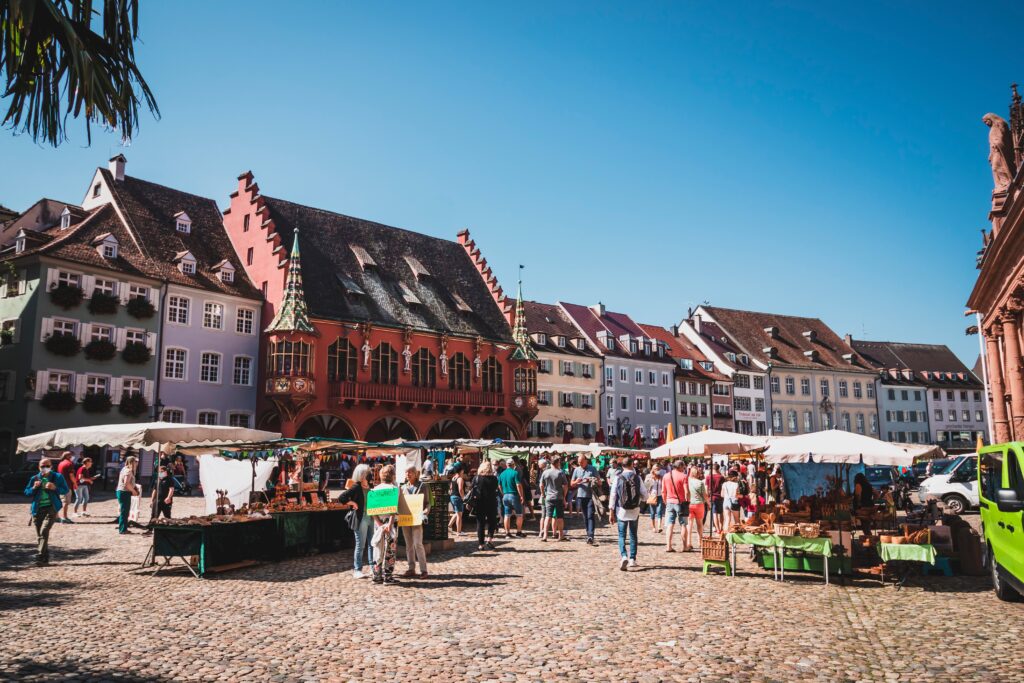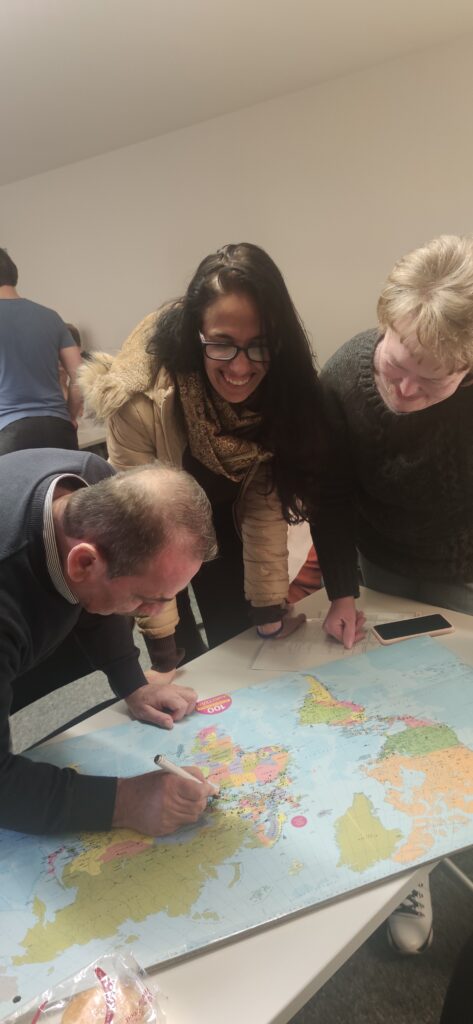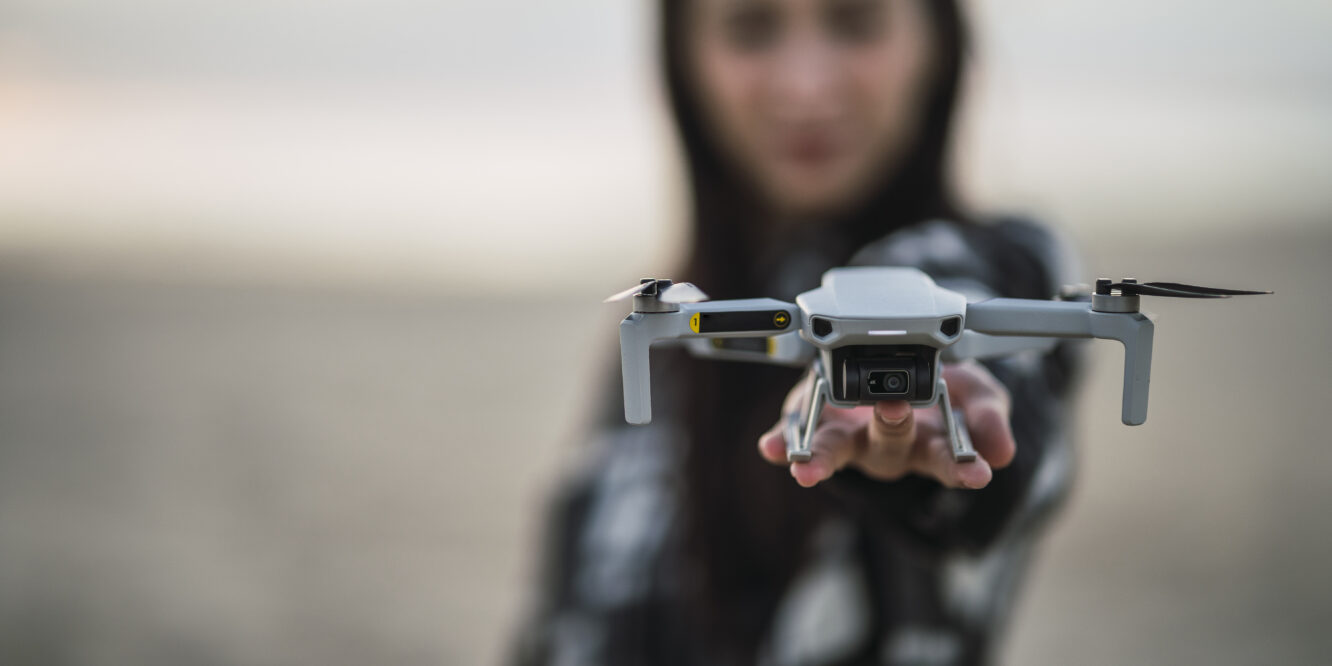Last week I enrolled for a “Deutsch Learning Café” open course hosted by the city library in Freiburg im Breisgau, at the Baden-Wurttemberg region, in Germany. I found it a great opportunity to mistake in German speaking with people who find German super hard and mistake just like you. The methodology is simple: they open the room for as many foreigners that come, they offer café and snacks and let us talk in groups with somehow similar speaking levels.
As a newcomer, starting level B1 of German and able to make a few short full sentences (probably with many mistakes and a strong Brazilian accent), I was assigned to be in the group with Victoriia (with 2 is, she insisted) and Dut, in the photo. She is a refugee of the Russia-Ukraine War, as most of the participants in the course and came to Freiburg last year. Dut came to Germany from Turkey, with 4 children, he did not mention why, but shared that it was around 11 years ago. On this period (2011-2012), even if it is not his case, Turkey had the fifth wave of emigration to Germany, people wanted to escape Erdogan’s authoritarian regime and searched for a new life abroad. Some feared an escalation of the Syrian-Turkish border clashes during the Syrian civil war.
I could not avoid thinking on my father, when listening to Viktoriia’s complaint about the challenge of learning German at her age. He lives in one of the most violent neighborhoods in Rio de Janeiro and refuse moving out to a different neighborhood with the argument that he is 78 years old and wants to die where he has lived his entire life. We build connections, has memories, cultural and emotional links to the land. I learned a lot about these connections with indigeneans people in Brazil and experience it every day, on the challenge of being an immigrant myself, even if it was my choice to enhance my academic degree, to project my career internationally to be able to help more people in need, but still to escape urban violence, unemployment, and social inequalities in Brazil (which I am still trying, by the way).



Photos: Freepik, pexels and private imagebank.
The three of us probably have never thought about learning German or living in Germany. We would be happy back in home, if we could find what the Sustainable Development Goal number 16: Peace, Justice and Strong Institutions seeks:
“How can a country develop—how can people eat and teach and learn and work and raise families—without peace? And how can a country have peace without justice, without human rights, without government based on the rule of law? Some parts of the world enjoy relative peace and justice, and may come to take it for granted. Other parts seem to be plagued by armed conflict, crime, torture and exploitation, all of which hinders their development. The goal of peace and justice is one for all countries to strive towards. The Sustainable Development Goals aim to reduce all forms of violence and propose that governments and communities find lasting solutions to conflict and insecurity. That means strengthening the rule of law, reducing the flow of illicit arms, and bringing developing countries more into the center of institutions of global governance.“ (UNDP website)
Therefore, I left the German conversation class with this idea in mind – of writing about how technology can play a role in achieving SDG 16. How can we use technology to promote peace, prevent or fight violent conflicts and help to build stronger institutions? Here I will share 3 ways, with different real examples:
Unfortunately, as we like to remember, Peace is not a white dove. The power that technological tools can add to prevent, control or mitigate conflicts are also applied for war. As this is not the focus of this article, I will not approach it here, but let this remind, as a reflection for your mental exercise. I suggest a reading on the “Artificial intelligence and the Modern Warfare” article, as an introduction to the topic.
As an obvious conclusion, technological tools are part of our contemporary society and as so, they will naturally be integrated into conflicts, peacemaking and war. The reflection we must do goes beyond the ‘HOW can we apply technology for peace?’ question. We should ask ‘WHO can play a relevant role to avoid conflicts or to mitigate them in specific areas’, ‘WHEN and for how long should those actors act’ , ‘WHAT are the resources we need or the means to get them to build more stable and strong societies’, and ‘WHERE these technological interventions for peace need to be prioritized’.
AUTHORSHIP: This article was written by the journalist and social scientist Elisa Maria Campos. It may pe reproduced totally or in parts as long as full attribution is made.

Sources used:
Ajluni, E. (2022, April 20). Germany’s migration crisis –. Observatory on Contemporary Crises. Retrieved February 12, 2023, from https://crisesobservatory.es/germanys-migration-crisis/#:~:text=Economists%20predict%20that%20the%20workforce,can%20add%20to%20Germany’s%20economy.
Giga (2022). Doom and gloom: Leaving Erdoğan’s Turkey. Retrieved February 12, 2023, from https://www.giga-hamburg.de/en/publications/giga-focus/doom-and-gloom-leaving-erdogan-s-turkey
Maia, R. (2022, April 29). Three ways technology can promote peace. Vision of Humanity. Retrieved February 12, 2023, from https://www.visionofhumanity.org/three-ways-technology-can-promote-peace/
Paris Call for Trust and Security in the Cyberspace: https://pariscall.international/en/
Thakur, A. H. K. (2023, January 15). Artificial Intelligence and the modern warfare. Modern Diplomacy. Retrieved February 12, 2023, from https://moderndiplomacy.eu/2023/01/16/artificial-intelligence-and-the-modern-warfare/

